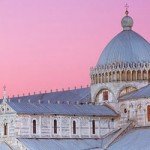There was a time when Christmas was not about decorated trees, Santa Claus, elves, reindeer and the like. It was about religion. The entire holiday season revolved around religious celebrations rather than decorations and expensive gifts. Few families had Christmas trees, but most of them had a “presepe”, the nativity scene.
Also known as crèche or crib in English, presepe is an ancient tradition. Saint Francis is said to have been the first to build one in the 13th century in the town of Greccio, in Lazio. The name comes from the Latin word praesaepe, which means “manger“.
Saint Francis’ presepe had real people impersonating the different characters, and it inspired many other communities to reenact the birth of Jesus on Christmas day through similar “presepi viventi“, real-life nativity scenes. They are still very popular today, and more and more towns organize real plays around Christmas time. In some cases, towns are completely transformed into a large nativity scene with local people in costume.
An Italian city with a long tradition of presepi is Naples, where the creation of amazing nativity scenes is a real form of art. Contemporary famous people are mixed in with traditional characters. Neapolitan artists work hard to make statues of the latest celebrity. President Obama and his Nobel Prize will be in this year’s nativity scene as well!
Some think that the origin of the Christmas crib is prior to the 13th century, and that its roots are actually in the Etruscan and Latin cult of lares familiares, the spirits of the dead ancestors, who were believed to watch over the family. Each of the ancestors was represented by a statuette called sigillum, “small image”, usually placed in niches in the house. On December 20, Romans celebrated Sigillaria, a holiday on which family members exchanged statuettes of the relatives dead during the last 12 months.
In the days leading to Sigillaria, children polished the sigilla and used them to create miniature pastoral scenes. The night before the holiday, the family would gather by this scene and pray to the souls of their ancestors and would offer them food and drink. The following morning, in place of the food and drink left for the lares, the children would find toys and gifts left behind by their grandparents or great-grandparents.
Christianity, as in many other occasions, kept the dates and the rituals, but changed their meaning. This one, though, continued for centuries in many regions, as it was deeply rooted in family memories and affections. In some areas, sigillaria was still celebrated up until the 15th century, although imbued of Christian meanings and symbolism. When Saint Francis introduced presepe as a way to reenact the events of the birth of Jesus to the moment of the arrival of the Three Wise Men, the tradition took on quite quickly and it has been a very popular way to celebrate Christmas in Italy ever since.
Presepe is a representation rich in symbols, most of which originate in Luke’s narration of the birth of Christ, such as the manger, the shepherds, and the angels in the sky. Other typical elements come from sacred art, such as St. Joseph’s humble attitude and the Virgin Mary’s blue mantle, representing the sky. A curiosity: since in the Canonical Gospels the nativity is described very vaguely, the unfailing presence of certain figures can be traced to Non-canonical Gospels, such as the donkey and the ox and the stable (or the cave, preferred in the Oriental tradition, probably because of the ancient cult of the Persian goddess Mitra, also born on December 25 in a cave). Even the Three Wise Men, Melkon, Gaspar e Balthasar are derived from the narration in a Non-Canonical Gospel.
Over the centuries, local traditions have added to the list of the omnipresent characters: thus, the Devil is almost always present in Neapolitan cribs and in Bologna, some characters (sometimes allegorical) are used, such as Awe, the “late riser” and the “curious woman“.
Some other interesting anecdotes about presepe. The most ancient known presepe was sculpted by Arnolfo di Cambio at the end of the 13th century and can be still admired in the museum of the Basilica of Santa Maria Maggiore in Rome. Some very famous names contributed to the success of the iconography of the nativity scene in the 14th century: Botticelli‘s Adoration of the Magi includes some members of the Medici family and is now housed in the Uffizi Gallery. Della Robbia made some beautiful terracotta sculptures representing the nativity scene: the most famous (and most beautiful) is in La Verna near Arezzo, another is in the Cathedral of Volterra. The oldest presepe with large statues (a very popular custom in the 16th century, when they were permanently on display in the major churches) is the monumental presepe of the Basilica di Santo Stefano in Bologna. More recently, mechanical presepi became popular for a while. Here is a list of the best ones:
- Presepe meccanico di San Pietro del Gallo (Cuneo)
- Presepe meccanico di Tarantasca
- Presepe meccanico di Vecchiazzano (Forlì)
- Presepe meccanico di Pallerone (Aulla).
- Presepe meccanizzato di Campo Ligure (Genova)
- Presepe meccanizzato with light effects in Nervi at the Confraternita del Rosario(Nervi)(Genova)
- Presepe meccanico di Manerba del Garda
There are many competitions dedicated to presepe. In Tuscany the most popular is the National Contest “Presepe Arnolfo di Cambio” in Colle Val d’Elsa.
This is an interesting article about Nativity Scenes in Italy, with suggestions on where to find the best ones.
*** Update ***
Here is a list of Presepi Viventi in Tuscany:
- Casole d’Elsa near Siena (December 26-27, January 3 and 6).
- Santa Brigida, near Florence (December 24 at 10pm, December 26 and January 6 at 6pm)
- Presepe vivente for children, Le Piagge, Florence (December 18)
- Presepe vivente, Montespertoli, Florence (December 24)
- Rosignano Marittimo near Livorno (December 24, 9pm to midnight and December 27, 3pm to 8pm)
- Barga near Lucca (December 23 at 8pm)
- Pescia near Pistoia (December 20, 3-7pm)
- Castelvecchio near Pistoia (December 24, 8 to 11:30pm)
- Pupigliana near Pistoia (December 19 at 5pm)
- Presepe vivente multietnico, Castel del Piano, Grosseto (December 28)
- Presepe vivente, Porto Ercole, Grosseto (December 25-27, January 6)
- Presepe vivente, Lari, Pisa (December 26)
Other events related to presepe in Tuscany:
- Natale nel mondo, Cappella del Pellegrino in the Basilica di Santa Maria delle Grazie in San Giovanni Valdarno, Arezzo, (December 8 – January 6).
- Pian di Sco, presepe vivente, Arezzo (December 19).
- 1000 presepi per Palazzuolo, Marradi, Florence (December 8 – January 6)
- Presepe artistico animato, Campi Bisenzio, Florence (December 13 – January 11)
- Presepi on display, Santuario di Montenero, Livorno (December 8 – January 6)
- Presepe artistico, Cigoli, Pisa (December 6 – January 13)
- Presepe poliscenico animato, Traversagna, Pistoia (December 25 – January 10)
- Mostra dei presepi, Bettolle, Siena (December 13 – January 6)
- Presepi of the contrade, Sarteano, Siena (December 20 – January 6)
- Presepe meccanico, Monticello Amiata, Grosseto (December 19 – January 7)













Nice article! I particularly like the art historical references ;-).
Where are the best presepe’s in Tuscany? I know there is a permanent display of presepi in San Giovanni Valdarno…
Ciao Alexandra! Thank you for your comment. In the article linked to in the post there is a list. I was trying to put together a list of “presepi viventi” in Tuscany. I’ll try to update my post as soon as possible with a few indications on where to find the best ones in Tuscany.
Excellent, thanks for this list!
Wonderful article of the historical background of the presepi…thanks! We much prefer this tradition to the artificial, meaningless glitz of elves and reindeer!
Thank you for your comment! I also like presepe! But I find the northern traditions magic and fascinating too! By the way, I love your blog http://2baci.blogspot.com/!